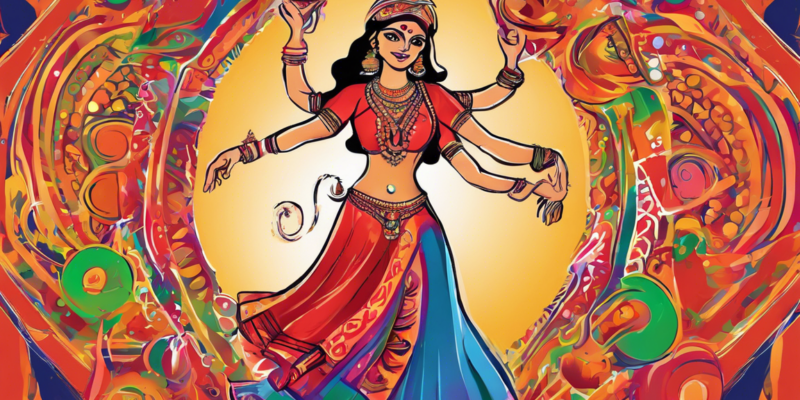Navratri, a nine-night Hindu festival celebrated with much pomp and fervor across India, is a time of vibrant traditions, rich culture, and beautiful colors. Each day of Navratri is associated with a different color, and devotees adorn themselves in these colors as a way of paying tribute to the various forms of Goddess Durga. This article delves into the significance of Navratri colors, the meanings behind them, and how you can incorporate them into your wardrobe and home decor to truly immerse yourself in the festive spirit.
The History and Significance of Navratri Colors
Navratri, which means “nine nights” in Sanskrit, is dedicated to the worship of Goddess Durga in her various forms. Each day is associated with a different avatar of the Goddess, and accordingly, nine different colors are assigned to each day. These colors are not just arbitrary choices but have deep symbolic meanings associated with them.
The Colors of Navratri and Their Symbolism
- Day 1: Grey (Pratipada): Grey symbolizes the calmness and peace that precedes the storm, signifying the beginning of a new journey.
- Day 2: Orange (Dwitiya): Orange represents energy and happiness, encouraging us to embrace joy and positivity.
- Day 3: White (Tritiya): White signifies purity and peace, reminding us to strive for inner clarity and tranquility.
- Day 4: Red (Chaturthi): Red symbolizes power and determination, urging us to be fearless in our pursuits.
- Day 5: Royal Blue (Panchami): Royal Blue represents strength and stability, reminding us to stand firm in our beliefs.
- Day 6: Yellow (Shashthi): Yellow symbolizes brightness and optimism, encouraging us to look towards a hopeful future.
- Day 7: Green (Saptami): Green signifies growth and harmony, reminding us to nurture our relationships and endeavors.
- Day 8: Peacock Green (Ashtami): Peacock Green represents beauty and grace, urging us to appreciate the beauty in our lives.
- Day 9: Purple (Navami): Purple symbolizes wisdom and spirituality, encouraging us to seek deep truths and enlightenment.
Incorporating Navratri Colors Into Your Wardrobe
- Grey: A grey saree or kurta with a pop of color in the accessories can make for a sophisticated look on the first day of Navratri.
- Orange: Embrace the vibrancy of orange with a flowy Anarkali suit or a traditional lehenga choli on the second day.
- White: Opt for an elegant white ensemble like a salwar kameez or a saree with intricate work on the third day of Navratri.
- Red: Stand out in a bold red outfit like a saree or a dress with traditional motifs on the fourth day.
- Royal Blue: Channel regal vibes with a royal blue lehenga or a kurta set embellished with gold accents on the fifth day.
- Yellow: Shine bright in a cheerful yellow dress or saree paired with sparkly accessories on the sixth day.
- Green: Go green with a chic green outfit like a sharara set or a cape-style dress on the seventh day.
- Peacock Green: Embrace the hues of nature with a peacock green saree or a floor-length Anarkali on the eighth day.
- Purple: Opt for a majestic purple lehenga or a kurta with intricate embroidery on the ninth day of Navratri.
Decorating Your Home with Navratri Colors
- Grey: Add grey cushions or a grey rug to your living room for a touch of elegance.
- Orange: Brighten up your space with orange curtains or throw pillows for a lively ambiance.
- White: Create a serene atmosphere with white flower arrangements or white candles in your home.
- Red: Infuse energy into your space with red table runners or red vases with fresh flowers.
- Royal Blue: Incorporate royal blue throws or artwork to bring a sense of sophistication to your home decor.
- Yellow: Spread cheer with yellow accent pieces like lamps or decorative bowls around your home.
- Green: Add a touch of nature with green plants or green wall art to create a calming environment.
- Peacock Green: Decorate with peacock green drapes or cushions to add a touch of opulence to your home.
- Purple: Incorporate purple rugs or curtains to bring a sense of regality and mystique to your living space.
Frequently Asked Questions (FAQs)
- What is the significance of Navratri colors?
-
The Navratri colors represent the different manifestations of Goddess Durga and are believed to bring positivity and blessings into one’s life when worn or adorned during the festival.
-
Can I mix and match Navratri colors in my outfits?
-
Yes, you can experiment with mixing and matching different Navratri colors in your outfits to create unique looks that reflect the festive spirit.
-
Are there specific traditions associated with each Navratri color?
-
While wearing the designated color of the day is a common practice, some people also perform rituals and prayers associated with each color to honor the respective form of Goddess Durga.
-
How can I incorporate Navratri colors into my makeup and accessories?
-
You can use makeup in the designated Navratri color of the day, such as eyeshadow or lipstick, and accessorize with jewelry or hair accessories that complement the chosen color.
-
Is it necessary to follow the Navratri color tradition?
- While it is not mandatory, embracing the Navratri color tradition adds to the festive spirit and allows one to connect with the spiritual significance of each color during the festival.
In conclusion, Navratri colors are not just a visual feast but also hold deep symbolic meanings that resonate with the essence of this auspicious festival. By embracing these colors in your attire and surroundings, you not only celebrate the spirit of Navratri but also invite positive energy and blessings into your life. So, immerse yourself in the beauty of these vibrant hues and revel in the festive joy that Navratri brings!

